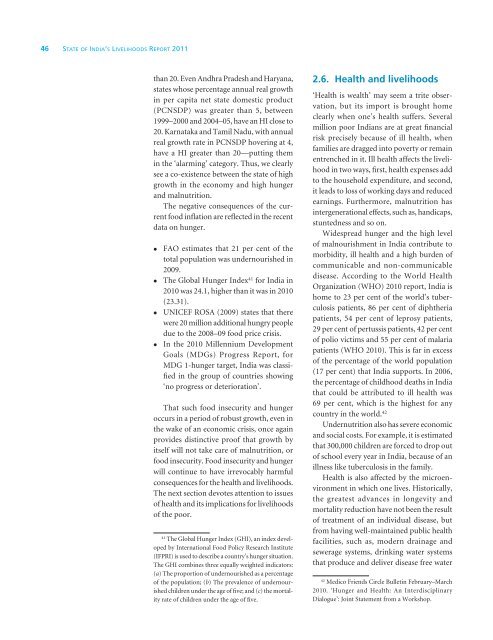SOIL Report 2011 - ACCESS Development Services
SOIL Report 2011 - ACCESS Development Services
SOIL Report 2011 - ACCESS Development Services
- No tags were found...
You also want an ePaper? Increase the reach of your titles
YUMPU automatically turns print PDFs into web optimized ePapers that Google loves.
46 State of India’s Livelihoods <strong>Report</strong> <strong>2011</strong>than 20. Even Andhra Pradesh and Haryana,states whose percentage annual real growthin per capita net state domestic product(PCNSDP) was greater than 5, between1999–2000 and 2004–05, have an HI close to20. Karnataka and Tamil Nadu, with annualreal growth rate in PCNSDP hovering at 4,have a HI greater than 20—putting themin the ‘alarming’ category. Thus, we clearlysee a co-existence between the state of highgrowth in the economy and high hungerand malnutrition.The negative consequences of the currentfood inflation are reflected in the recentdata on hunger.• FAO estimates that 21 per cent of thetotal population was undernourished in2009.• The Global Hunger Index 41 for India in2010 was 24.1, higher than it was in 2010(23.31).• UNICEF ROSA (2009) states that therewere 20 million additional hungry peopledue to the 2008–09 food price crisis.• In the 2010 Millennium <strong>Development</strong>Goals (MDGs) Progress <strong>Report</strong>, forMDG 1-hunger target, India was classifiedin the group of countries showing‘no progress or deterioration’.That such food insecurity and hungeroccurs in a period of robust growth, even inthe wake of an economic crisis, once againprovides distinctive proof that growth byitself will not take care of malnutrition, orfood insecurity. Food insecurity and hungerwill continue to have irrevocably harmfulconsequences for the health and livelihoods.The next section devotes attention to issuesof health and its implications for livelihoodsof the poor.41The Global Hunger Index (GHI), an index developedby International Food Policy Research Institute(IFPRI) is used to describe a country’s hunger situation.The GHI combines three equally weighted indicators:(a) The proportion of undernourished as a percentageof the population; (b) The prevalence of undernourishedchildren under the age of five; and (c) the mortalityrate of children under the age of five.2.6. Health and livelihoods‘Health is wealth’ may seem a trite observation,but its import is brought homeclearly when one’s health suffers. Severalmillion poor Indians are at great financialrisk precisely because of ill health, whenfamilies are dragged into poverty or remainentrenched in it. Ill health affects the livelihoodin two ways, first, health expenses addto the household expenditure, and second,it leads to loss of working days and reducedearnings. Furthermore, malnutrition hasintergenerational effects, such as, handicaps,stuntedness and so on.Widespread hunger and the high levelof malnourishment in India contribute tomorbidity, ill health and a high burden ofcommunicable and non-communicabledisease. According to the World HealthOrganization (WHO) 2010 report, India ishome to 23 per cent of the world’s tuberculosispatients, 86 per cent of diphtheriapatients, 54 per cent of leprosy patients,29 per cent of pertussis patients, 42 per centof polio victims and 55 per cent of malariapatients (WHO 2010). This is far in excessof the percentage of the world population(17 per cent) that India supports. In 2006,the percentage of childhood deaths in Indiathat could be attributed to ill health was69 per cent, which is the highest for anycountry in the world. 42Undernutrition also has severe economicand social costs. For example, it is estimatedthat 300,000 children are forced to drop outof school every year in India, because of anillness like tuberculosis in the family.Health is also affected by the microenvironmentin which one lives. Historically,the greatest ad vances in longevity andmortality reduc tion have not been the resultof treatment of an in dividual disease, butfrom having well-maintained public healthfacilities, such as, modern drainage andsewerage sys tems, drinking water systemsthat pro duce and deliver disease free water42Medico Friends Circle Bulletin February–March2010. ‘Hunger and Health: An InterdisciplinaryDialogue’: Joint Statement from a Workshop.














